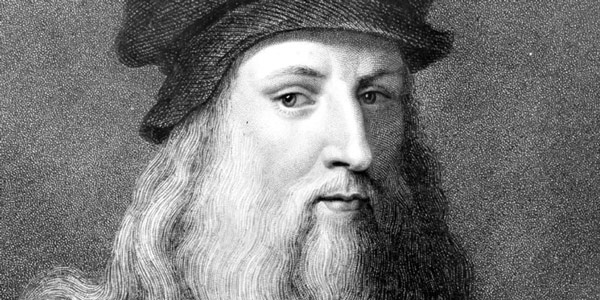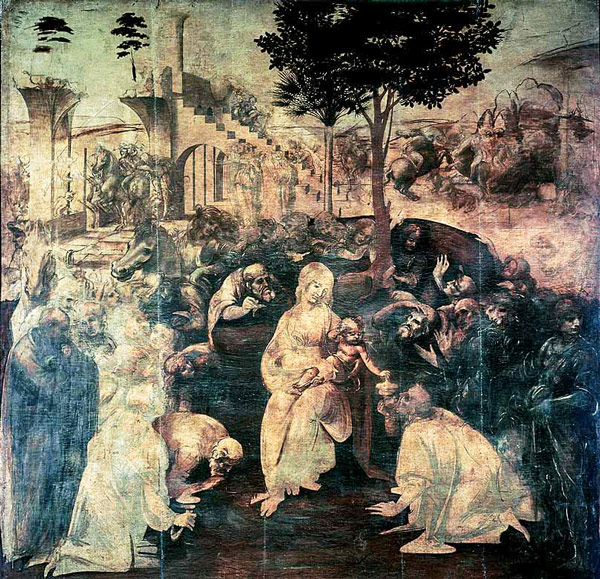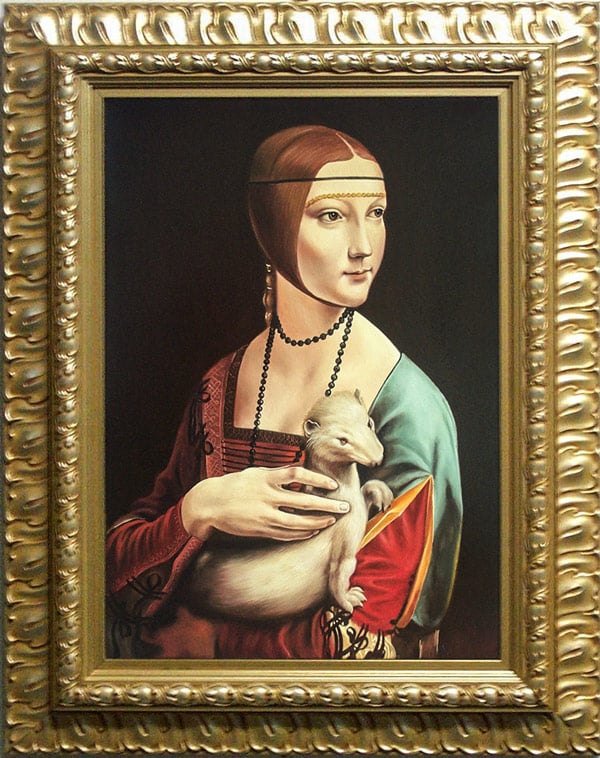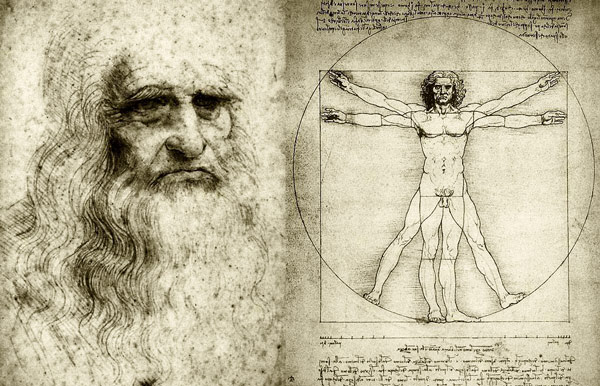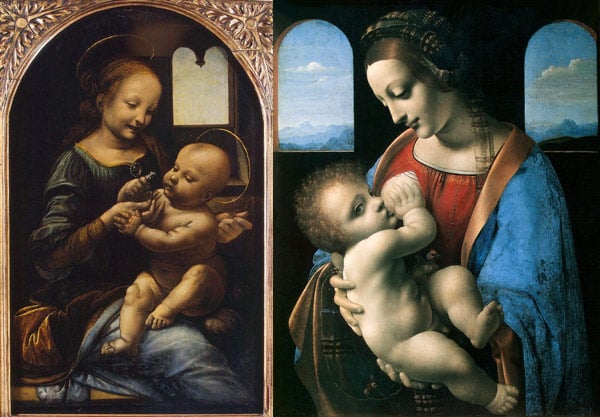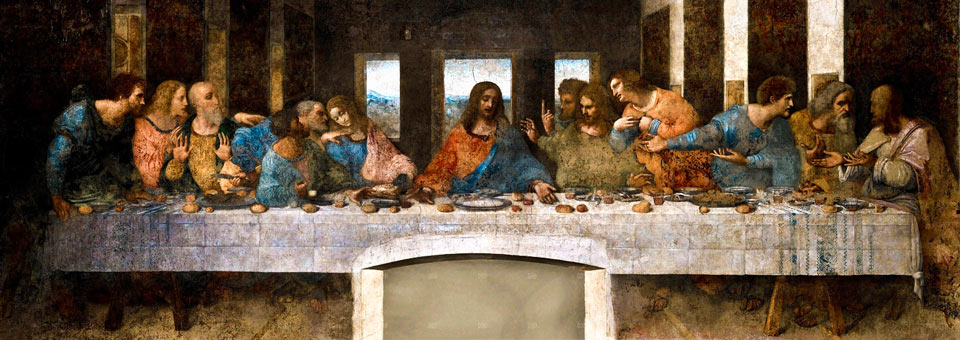Leonardo da Vinci – a great Italian Renaissance artist and inventor, was born on April 15, 1452, in the small village of Anchiano LU, near Vinci FI.
He was the illegitimate son of a wealthy notary, Piero da Vinci, and a beautiful woman, Katarina. Soon after this event, the notary got married with a girl of noble birth. However, they had no children, therefor Piero and his wife took his three-year-old child to live with them.
Page Contents
Biography of Lenardo da Vinci
The brief time of childhood in the village had passed. Piero moved to Florence, where he gave his son as an apprentice to Andrea del Veroccio, the famous Tuscan master. There, in addition to painting and sculpture, the future artist was able to learn the basics of anatomy, mathematics and mechanics, working with metals, plaster, and leather. The young man greedily absorbed knowledge and later used it extensively in his work.
The angel painted by Leonardo so clearly demonstrated his superiority over his teacher that the latter put his brush away and never painted again.
Leonardo gained his qualifications by the Guild of St. Luke. Leonardo da Vinci spent the next year of his life in Florence. His first mature painting is The Adoration of the Magi (Adorazione dei Magi), ordered by monastery of San Donato (San Donato).
The Milanese period (1482 – 1499)
Lorenzo di Medici sent Leonardo to Milan as a messenger of peace by to Lodovico Sforza (Moro). Here his work took a new direction. He was enrolled in the court staff first as an engineer and only later as an artist.
Duke of Milan, a cruel and short-sighted man, had little interest in Leonardo’s creativity. Leonardo cared even less about the ducal indifference. They had only one common interest. Moro needed engineering devices for military operations and mechanical structures for the amusement of the court. Leonardo knew this topic pretty well. The master was convinced that the possibilities of man are limitless. His ideas were close to the humanists of Modern times, but in many respects incomprehensible to his contemporaries.
Two important works belong to the same period: the fresco ‘The Last Supper’ (Il Cenacolo) for the refectory of the convent of Santa Maria della Grazie (Chiesa e Convento Domenicano di Santa Maria delle Grazie) and the painting ‘The Lady with the Ermine’ (Dama con l’ermellino).
In ‘Lady with the Ermine’ Leonardo depicted Cecilia Gallerani – a favourite of the Duke of Sforza. Cecilia’s biography was unusual. One of the most beautiful and scholarly ladies of the Renaissance, she was kind, able to get along with people. An affair with the Duke saved one of her brothers from prison. Leonardo and Cecilie were in extremely affectionate relationship, but, according to contemporaries and the opinion of most researchers, their brief connection remained platonic.
A more widespread (and also unconfirmed) rumor is Leonardo’s intimate relationship with his pupils Francesco Melzi and Salai. But the master always kept his private life really a private one.
Moro ordered the equestrian statue of Francesco Sforza. Leonardo made the sketches, and a clay model of the future monument. But further work was prevented by the French invasion of Milan. The artist went to Florence. Later, the artist would come back, but to another lord – the French King Louis XII (Louis XII).
Back in Florence (1499-1506)
His return to Florence was marked by his entry into the service of Duke Cesare Borgia and the creation of his most famous painting, the ‘Gioconda’.
The new work involved frequent travels, that’s why Leonardo da Vinci traveled a lot around Romagna, Tuscany and Umbria with various assignments. His main mission was to reconnoitre and prepare the area for hostilities on the part of Cesare, who was intent on subjugating the Papal Region. Cesare Borgia was considered the greatest evil of Christendom, but Leonardo admired his tenacity and exceptional talent as a commander. He argued that the vices of the Duke are balanced by “equally great virtues”. The great adventurer’s ambitious plans did not materialize. Leonardo returned to Milan in 1506.
The later years (1506 – 1519)
The second Milanese period lasted until 1512. He studied the structure of the human eye, and worked on a sculpture of Gian Giacomo Trivulzio and his own self-portrait. In 1512, the artist moved to Rome. Giovanni di Medici, son of Lorenzo the Magnificent, was elected pope under the name of Leo X. The pope’s brother, the Duke Giuliano di Medici, had a high regard for his compatriot’s work. After his death, he accepted the invitation of King François I and went to France in 1516.
Francis proved to be a most generous and grateful patron. The maestro settled in the picturesque Château of Le Clos Lucé in Touraine. There he was free to pursue whatever interested him. On a royal order Leonardo created a lion with a bouquet of lilies opening from its breast. The French period was the happiest in his life. The King gave da Vinci an annual rent of 1,000 ecus and land and vineyards, giving him a peaceful old age. Leonardo died in 1519. He left his notes, instruments and estates to his pupils.
Paintings of Leonardo da Vinci
‘Holy Virgin’
Two depictions of the Holy Virgin by Leonardo, Madonna Benois and Madonna Litta, painted 10 years apart. Both paintings can be found in the State Hermitage Museum, St. Petersburg, Russia.
‘Vitruvian Man’
The drawing ‘Homo vitruviano’, showing a man of “ideal proportions”, is in the collection of the Gallerie dell’Accademia in Venice.
‘The Last Supper’
The fresco ‘The Last Supper’, depicting the last supper of Christ, began to deteriorate during his lifetime. Francis I wanted to transport the wall of the monastery refectory to France to save the masterpiece.
‘Gioconda’
‘Gioconda’ is Leonardo’s most debated work. The main mystery is who posed for the artist? They call Lisa del Giocondo, wife of a noble Popolan, Costanza d’Avalos, mistress of Giuliano de Medici…
The most nontrivial versions are that “Gioconda” is Da Vinci himself or his apprentice Salai, dressed as a woman. There’s a lot of speculation and even more copies, but the immortal Mona Lisa continues to charm us with her inimitable smile.
Inventions and works of Leonardo da Vinci
Most of Leonardo’s inventions were not created during his lifetime, remaining only in notes and drawings. Airplane, bicycle, parachute, tank… He possessed a dream of flight, the scientist believed that man could and should fly. He studied the behavior of birds and sketched wings of different shapes. Da Vinci’s project of double-lens telescope is surprisingly accurate, and there is a brief entry about the possibility “to see the moon big” in his notes.
As a military engineer he was always in demand, the light bridges he invented and the wheel lock for pistols were used everywhere. Leonardo dealt with problems of urban planning and land reclamation, and in 1509 he built the St. Christopher’s Canal and the Martesana Irrigation Canal. The Duke of Moro rejected his project of an “ideal city”. A few centuries later, London was built according to this project. In Norway there is a bridge built according to Leonardo da Vinci’s drawing. In France, being an old man, he designed the canal between the Loire and the Saône.
Leonardo’s diaries are written in an easy, lively language and are interesting to read. His fables, parables and aphorisms speak of the versatility of the great mind.
The works of Leonardo da Vinci can be seen in specialized museums in Rome, Milan, as well as in Venice.
The mystery of a genius
There were plenty of secrets in the life of the artist. One of them was revealed relatively recently. But has it been revealed? In 1950, was published a list of Grand Masters of the Priory of Sion (Prieuré de Sion) – a secret organization founded in 1090 in Jerusalem. According to the list, Leonardo da Vinci was the ninth of the Grand Masters of the Priory. His predecessor in this position was Sandro Botticelli and after Leonardo it was succeeded by the connetable Charles III de Bourbon. The main goal of this community was to restore the Merovingian dynasty to the throne of France. The offspring of this family were considered descendants of Jesus Christ by the Priory.
The very existence of such an organization raises doubts among most historians. But such doubts may have been sown by members of the Priory who wished to continue their activities in secrecy.
If one accepts this version as truth, da Vinci’s habit of complete independence and the strange attraction to France for a Florentine becomes understandable. Even Leonardo’s style of writing – left-handed and right-to-left – can be interpreted as an imitation of Jewish writing. This seems unlikely, but the scale of his personality allows the boldest assumptions to be made.
Stories about the Priory are distrusted by scholars, but they enrich artistic creation. The most notable example is the book “Da Vinci Code” by Dan Brown and the movie of the same name.
Interesting Facts
- At the age of 24, along with three Florentine young men, he was accused of sodomy. But they acquitted for lack of evidence.
- Leonardo da Vinci was a vegetarian. He called people who consumed animal food “walking cemeteries.”
- He shocked his contemporaries with his habit of sketching hanging men in detail. He considered the study of the human body as the most important one.
- There is an opinion that the maestro was making for Cesare Borgia tasteless and odorless poisons and listening devices made of glass tubes.
- The television mini-series La vita di Leonardo da Vinci, directed by Renato Castellani, won a Golden Globe Award.
- Rome’s Fiumicino airport is named after Leonardo da Vinci. Besides, here is a huge statue depicting the master, who holding a model of helicopter in his hands.
 Italy for me From Italy with love
Italy for me From Italy with love

